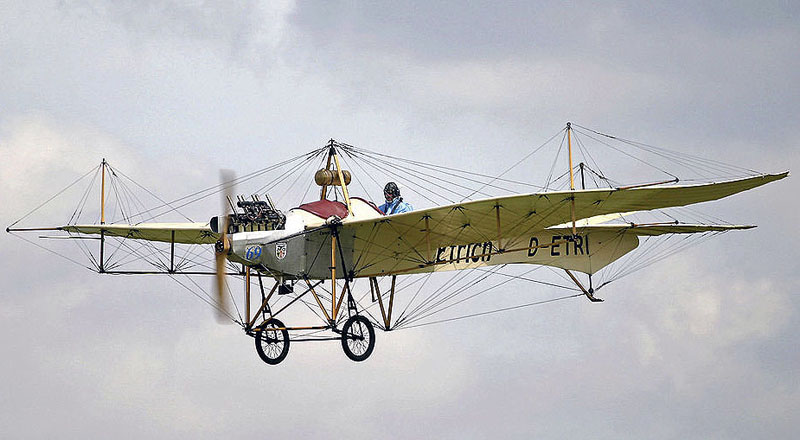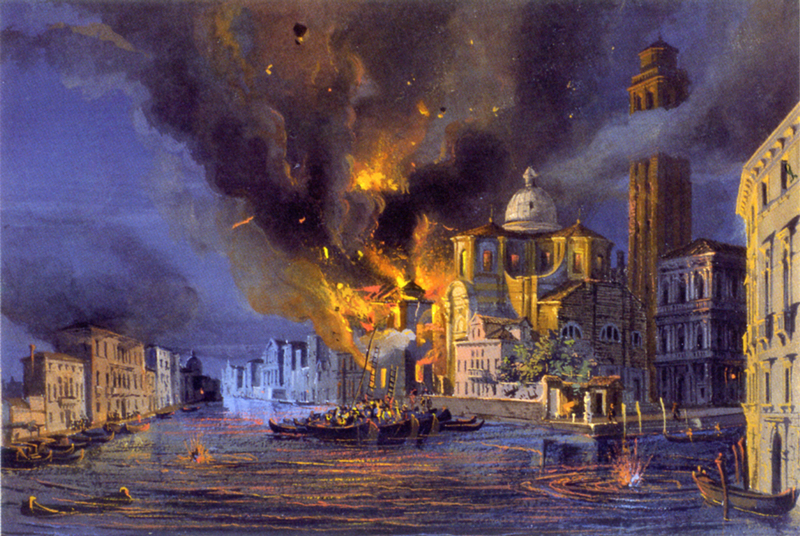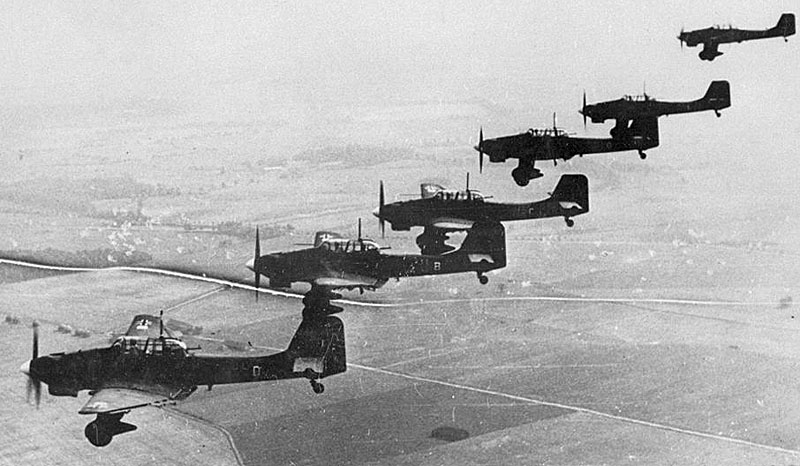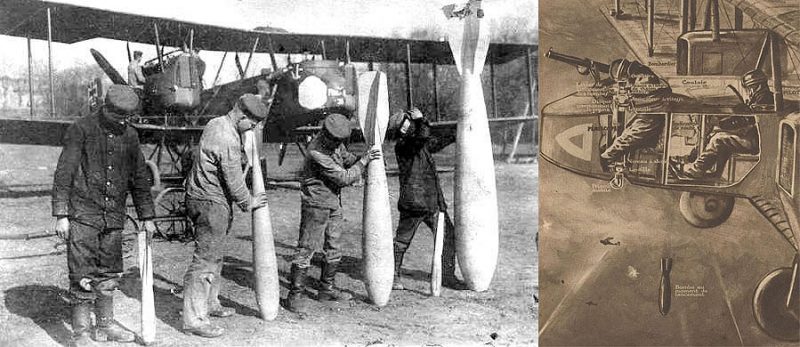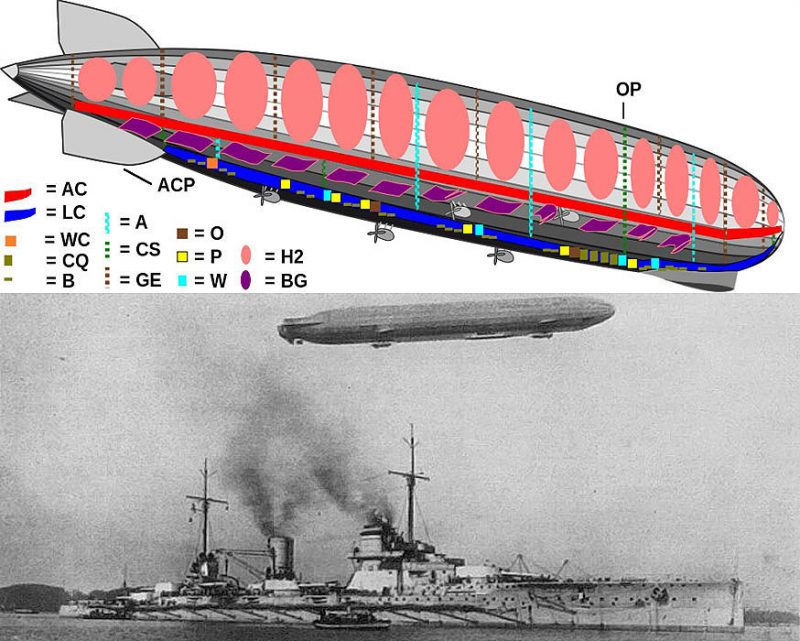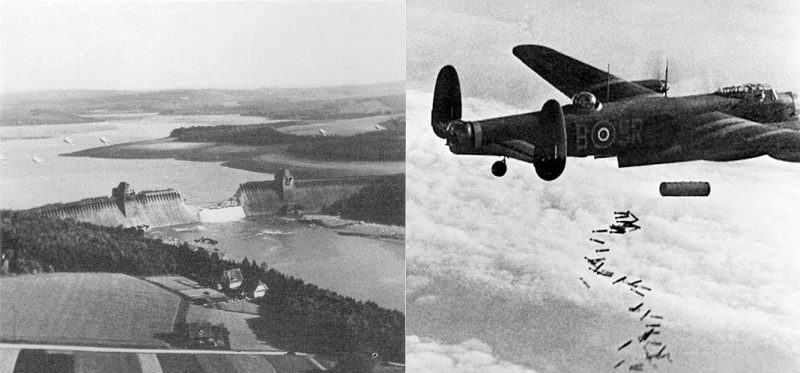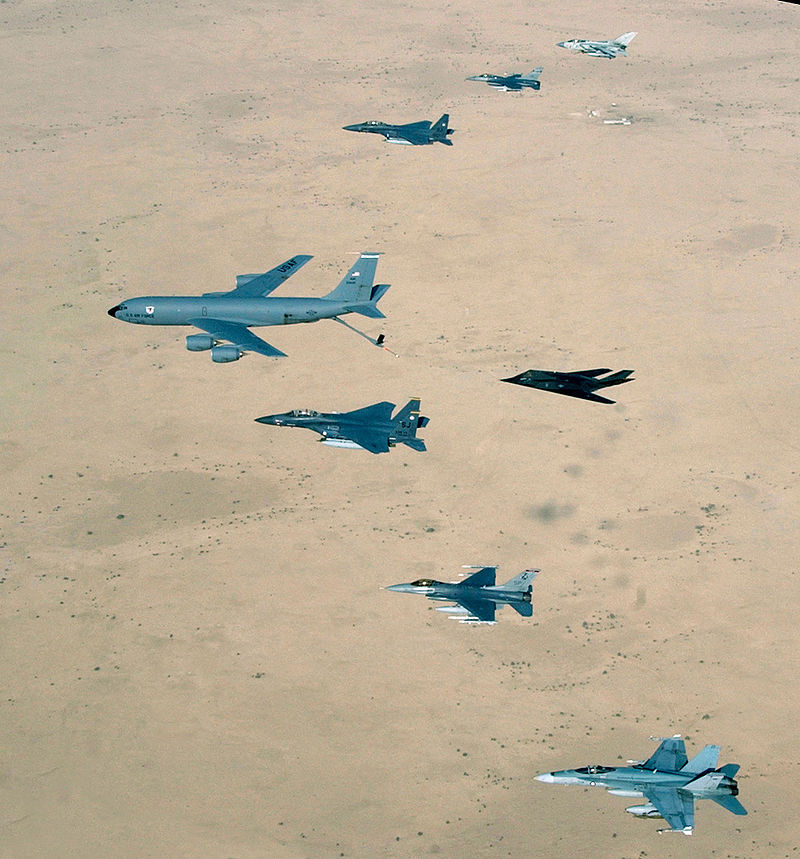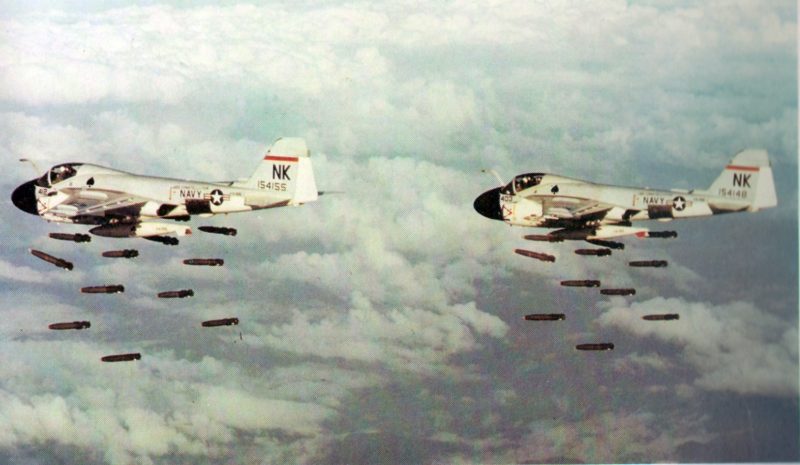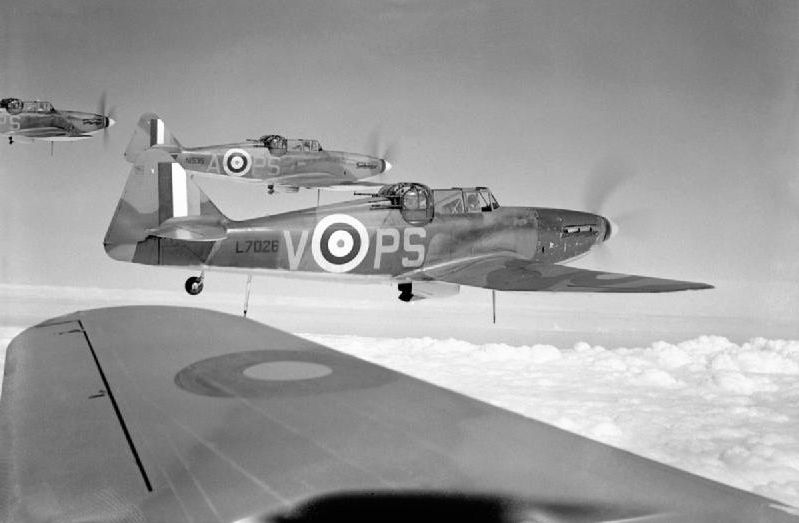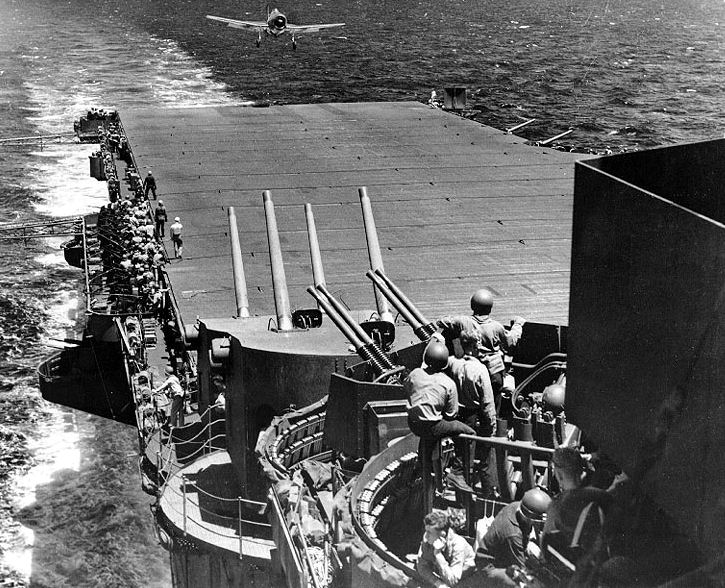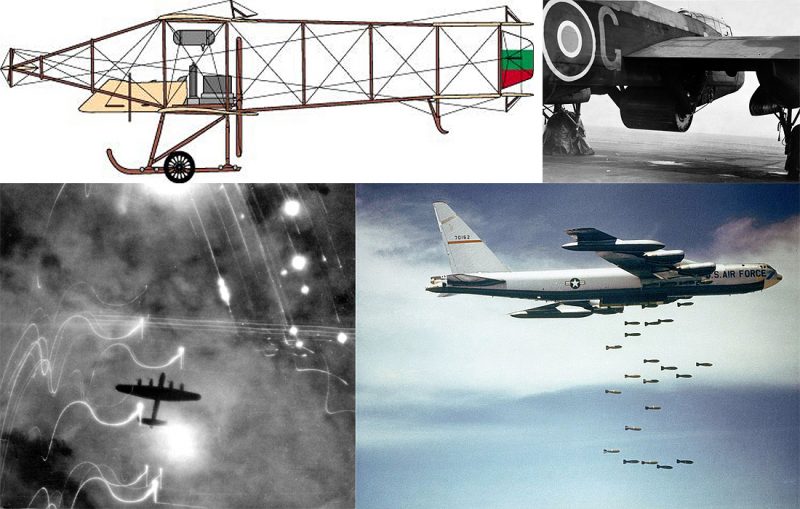
Images Used (Clockwise from top left): (1) First true bombs were dropped in autumn 1912 on a Turkish railway station from an Albatros F-2 aircraft by Bulgaria during First Balkan War (2) A bouncing bomb mounted under specially designed Lancaster B III during Operation Chastise. (3) A USAF Boeing B-52F Stratofortress dropping M117 bombs, each with a weight of 750 lb (340 Kg), over Vietnam in 1965/1966 (4) An Avro Lancaster bomber over Hamburg, Germany during Allied bombing in July 1943
A ‘bird’s eye view’ was provided to each side of WWI combatants, thanks to the newly invented airplanes. Aerial Warfare is the use of different types of military aircraft in warfare. Such warfare includes bombers attacking important targets or enemy concentrations, fighter aircraft battling for controlling the airspace, attack aircraft involving in close air support, naval aircraft engaging against sea and land targets, aerial refueling tankers increasing operation range and time, helicopters and gliders carrying airborne forces and reinforcements and military transport aircraft carrying troopers and cargo. Historical aerial battles included the use of observers in air balloons directing artillery. Modern aerial conflicts deploy aircraft for reconnaissance, early warning, surveillance, bombing torpedoes, air-sea rescuing, firing missiles. Deployment of unmanned aerial vehicles (UAV) or drones is also a significant part of modern aerial warfare. Online edition of renowned British middle-market tabloid news paper, The Daily Mail presented a list of top 10 Greatest Aerial Battles from the first bombs from an aircraft in 1911 to the modern day aerial warfare.
(1) The First Bombs Dropped From An Airplane in Libya During the Italo-Turkish War in 1911:
Kingdom of Italy and Ottoman Empire fought the Italo-Trukish war in the Tripolitania (Ottoman Libya), Eastern Mediterranean, Aegean Sea and the Red Sea from September 29, 1911 to October 18, 1912. Ottoman Empire had been declining and after Turkey’s defeat by Russia in the Russo-Turkish War of 1877-1878, Britain and France agreed to the occupation of Cyprus and Tunisia respectively. Cyprus and Tunisia had been the parts of a declining Ottoman Empire earlier. Italian diplomats hinted about a possible opposition against the British and French rule over Cyprus and Tunisia. In reply, France had encouraged an Italian invasion of Tripoli and a secret treaty was signed in 1902 between Italy and France to invade Ottoman Libya and Morocco.
However, Italian government was in no hurry to take control of the Libyan territory which was defended by only around 4,000 Ottoman troopers. Ottoman Government was presented with an ultimatum by the Italian Government in September 1911 about transferring control of Libya. For Libya, the Ottomans proposed a type of transfer of control that took place in the case of Egypt. Egypt remained under Ottoman suzerainty, but the United Kingdom actually controlled the North African territory. Italian Prime Minister Giolitti refused the proposal and war began on September 29, 1911. Total 100,000 Italian combatants with 82 artillery pieces had to face 8,000 Turks and 20,000 Arabs in Libya.
From October 3, 1911, the Italian fleet and dirigibles or airships started bombarding Turkish positions. World’s first aerial reconnaissance was carried out by Italian pilot, Captain Carlo Piazza, who flew over Turkish lines on October 23, 1911 and accomplished the mission. The first ever aerial bombs were dropped from an airplane by Italian Second Lieutenant and pilot Giulio Gavotti on November 1, 1911. He flew his early model monoplane, Etrich Taube, extracted grenade pins with his teeth and threw four 4.5 lb grenades from around 300 ft onto the Ottoman base below. Monoplanes were the planes with one pair of wing. Biplanes were common during that time with one pair of wing installed over another pair. The Etrich Taube was powered by a four cylinder liquid-cooled engine. Gavotti tossed 3 grenades onto the Tajiura oasis and the other one onto the military camp at Ain Zara. Nobody was injured in the attack. After these bombardments from airships and aircraft, Ottoman Empire issued a protest and there was an international enquiry. Because, according to 1899 Hague Convention, dropping bombs from balloons had been banned.
The first historical night mission of an airplane was also performed by Gavotti on March 4, 1912 during the
same campaign. However, the first true bomb with a detonator and fins was designed in 1912 by a Bulgarian soldier, Simeon Petrov. Two of those bombs were dropped in autumn 1912 on a Turkish railway station from an Albatros aircraft by the Balkan League formed by the Balkan states of Bulgaria, Greece, Serbia and Montenegro during the First Balakan War. Albatros-Flugzeugwerke was a German manufacturing company that built five Albatros F-2s in 1912 and sold four of these biplanes to Bulgaria. Bulgaria used these in the Balkana wars. Design of the Albatros aircraft became standard during the WWI and Albatros-Flugzeugwerke produced around 10,300 aircraft for the German Air Forces during WWI.
Image Used: An Etrich Taube aircraft during ILA Berlin Air Show in 2004. The first ever aerial bombs were dropped from one such aircraft.
(2) The Siege of Venice, 1849:
Republic of Venice remained independent for nearly 1400 years until 1797 when it surrendered to Napoleon during the French Revolutionary War. Subsequently, Venice was handed over to Austrian Empire as part of a treaty. Austria exploited the resources of Venice both politically and economically. Venetians challenged the Austrian rule and the Italian Revolutionary state, Republic of San Marco was formed in 1848 and it lasted until August 28, 1849 when the Austrian troops re-conquered it. Austrian forces had been besieging Venice during the revolution and on around July 15, 1849, Austrian forces launched the first aerial attack using balloons that carried 30lb bombs. This balloon bomb was invented by Austrian inventor and artillery general, Franz von Uchatius. His balloons were made of paper and could stay aloft for 30 minutes carrying the bombs. These had been planned to be released up wind and upon reaching the airspace over the enemy, timed fuses were supposed to release the bombs. Uchatius released the balloons from a battleship but the wind was too strong and many of the balloons drifted across the besieged city and fell on his fellow soldiers encamped on the main land.
Image Used: Austrian bombardments of 1849 hit the church of San Geremia in Venice
(3) Battle Of Bzura, 1939:
Aircraft were proved to be of real importance in support of ground forces for the first time during the Nazi invasion of Poland in September 1939. Nazi Germany, its client state Slovak Republic (now Slovakia) and Soviet Union invaded Poland on September 1, 1939. The Polish Air Force could mobilize only 397 aircraft against a powerful German Air Force. During that time, Germany had around 4,000 aircraft and 2,315 of those bombers, fighters and dive-bombers were assigned to the ‘Poland Campaign’. Though numerically inferior and outmatched by advanced German aircraft, the Polish Air Force remained active up to the second week of the campaign and caused significant damage to the Luftwaffe. 285 German aircraft were destroyed with 279 more damaged. The Poles, on the other hand, lost 333 aircraft. The advantage of aircraft during a battle was properly demonstrated during the Polish counter-attack during the Battle of Bzura from September 9, 1939 to September 19, 1939. The German aircraft repeatedly strafed and bombed the Polish forces until the Poles were outflanked at the end of the Battle of Bzura. The invasion of Poland ended on October 6, 1939, with Germany and Soviet Union dividing Poland between themselves.
Image Used: German dive bombers, Junkers Ju 87 Bs over Poland during the invasion of Poland in September/October 1939
(4) WWI Inter-Allied Independent Air Force, 1918:
After the generally unsuccessful bombing raids on German held targets by Royal Naval Air Service through the late 1916 and early 1917, Royal Air Force was founded on April 1, 1918 as the first air force independent of navy or army control. On May 18, 1918, Independent Air Force (IAF) or Inter-Allied Independent Air Force was formed. It was part of the Royal Air Force and a strategic bombing force intended to be used to strike against German aerodromes, industries and railways. It operated independently without co-ordination with the Navy or Army. IAF became active on June 6, 1918 with its headquarters near Nancy in north-eastern France. Long range attacks were carried out by IAF in the enemy homeland. The first waves of attacks were carried out in September 1918 against cities in the western Germany. The IAF dropped total 550 tons of bombs including 390 tons of bombs dropped at night. Most of the bombs were dropped on German railways and around 220 tons were dropped on German aerodromes causing some damages. IAF lost 109 aircraft during these operations. On the other hand, German aerial attacks on British aerodromes were minimal and no British aircraft were destroyed on the ground due to bombing. There were plans to set up a fleet of 48 bombing squadrons but WWI ended before Independent Air Force could achieve substantial successes and the first true strategic bombing campaign was suspended.
Images Used (from left): (1) Different types of bombs were used by the German heavy bomber Gotha G.V (2) Illustration of German Gotha crew in action during WWI
(5) Entente Strategic Bombing of The Zeppelin Sheds, 1914:
During WWI, the Allied forces were formed based on the Triple Entente of the United Kingdom, France and Russian Empire. They were up against the Central Powers based on the Triple Alliance of Germany, Austria-Hungary and Italy. The alliances were expanded as Italy changed side and joined the Allies along with the United States and Japan. The Ottoman Empire and Bulgaria soon joined the Central Powers.
German Count Ferdinand Zeppelin pioneered the development of one type of rigid airship. It was formulated in 1874; development had been completed in 1893 and was named after him. Zeppelins were patented in Germany in 1895 and in the United States in 1899. German Zeppelins were a menace to the British cities and shipping during the WWI. The Germans used the Zeppelins to scout and to carry out bombing raids, killing over 500 people in Britain.
The first Entente strategic bombing missions were undertaken by Royal Naval Air Service on September 22 and October 8, 1914, when it bombed the Zeppelin bases in the German cities Cologne and Düsseldorf. The British airplanes carried twenty-pound bombs and at least one Zeppelin was destroyed in the attack. RNAS flew across Lake Constance in Germany on November 21, 1914 and bombed Zeppelin factories in Ludwigshafen and Friedrichshafen. Sea based airplanes were used for the first time to launch an attack during the Cuxhaven Raid in Germany on Christmas Day, 1914. These effective raids continued into 1915.
Images Used (from top): (1) Schematic showing the internal diagram of an LZ 127 Zeppelin where the pink ovals showing hydrogen cells (H2) inside the airship; the magenta element showing the illuminating blaugas cells (BG) which is similar to propane. ACP is Auxiliary control post, AC is axial corridor, LC is lower corridor, WC is crew’s toilet, CQ is crew’s quarters, B is berths or cargo space, A is ventilation shaft, CS is climbing shaft, GE is exhaust gas shaft, O is oil tanks, P is petrol tanks, W is water tank, OP is Observation post on top of hull (2) A German battle cruiser SMS Seydlitz with a Zeppelin flying over it during WWI
(6) The Dam Busters or Operation Chastise, 1943:
British Air Ministry had identified the heavy industrialization of the Ruhr Valley in the valley of the Ruhr River in northwestern Germany prior to WWII. As a result, this important location, especially its dams with hydroelectric power stations were marked as important strategic targets.
Total 19 RAF modified ‘Avro Lancaster Mk III’ bombers divided into 3 formations attacked the main dams on the night of May 16, 1943. It was one of the most remarkable precision bombing incidents of WWII. English inventor, scientist and engineer Barnes Wallis invented the specially designed bouncing bomb that could bounce towards a target across water avoiding obstacles such as- torpedo nets. Success of this mission depended on the success of these bombs to hit the dams. A specially trained squadron number 617 led by Wing Commander Guy Gibson took part in Operation Chastise. First of the three formations reached the Möhne dam with 5 aircraft but one was soon hit. The bombers successfully breached the dam and soon, Eder dam was breached too. The second formation lost 4 out of 5 aircraft and though the remaining aircraft could drop one bomb successfully on the Sorpe Dam, the main body of the dam remained functional. 11 out of the total 19 aircraft were lost. Over 70 square miles were flooded and at least 1650 people were killed in the operation. German food production in the area was significantly affected due to this operation. Though it could not do significant damage to Germany’s industrial production, the bombings and damaged German dams were great boosts for the morale of the Allies.
Images Used (from left): (1) The Möhne dam photographed on the day following Operation Chastise on May 17, 1943 (2) Avro Lancaster Bomber dropping a 4,000 lb cookie or blockbuster bomb and bundles of incendiary bombs over Duisburg in Germany in October, 1944
(7) Shock and Awe Doctrine during Invasion of Iraq, 2003:
The Shock and awe or rapid dominance military doctrine was coined by Vietnam Veteran Harlan K. Ullman and author James P. Wade in 1996. This doctrine advocates the use of overwhelming force, dominant battlefield maneuvers and spectacular displays of brute force to paralyze the enemy’s understanding of the battlefield scenario and crushing its will to fight. United States planned to test the effectiveness of the shock and awe strategy during the 2003 invasion of Iraq. There was even dissent within the Bush Administration about the effectiveness of the shock and awe plan. United States had invaded Afghanistan earlier in 2001.
David Martin, a CBS Correspondent, mentioned that the US forces were surprised by the willingness of Al Qaeda militants to fight to death in Afghanistan. He added that if similar situation happened in Iraq, then United States would have to depend on lots of reinforcements to win the war with lots of casualties on both sides.
On March 19, 2003, the United States started continuous bombing in an attempt to kill Saddam Hussein. The main bombing campaign started on March 21, 2003, when the US and its allies launched around 1,700 air sorties, 504 of which were Tomahawk Land Attack Missiles (TLAM) and Conventional Air-Launched Cruise Missiles (CALCM). Sortie is the deployment of one military unit. Coalition ground forces had started offensive towards Baghdad on the previous day and seized Baghdad on April 5, 2003. Finally, the US declared victory on April 14, 2003. The US and its allies had 380,000 troopers and the Iraqi Forces had around 487,000 combatants with 650,000 reserves. Only 139 US combatants, 33 British combatants and 24+ Kurdish soldiers were killed in the conflict with 551 more US troopers were wounded while around 30,000 Iraqi combatants and 7,269 Iraqi civilians were killed during the invasion of Iraq. An organization in UK estimated that approximately 6,616 Iraqi civilians were killed during the shock and awe invasion phase of the battle. Perhaps only nuclear weapons can achieve a quicker victory in a war than shock and awe doctrine.
Image Used: US Air Force over Iraq on April 14, 2003. KC-135 Stratotanker (that looks a passenger aeroplane), F-16 Fighting Falcon, McDonnell Douglas F-15 Eagle, Boeing F/A-18 Hornet, F-117 Nighthawk (that looks like an alien aircraft or UFO), Panavia Tornado
Video Used: 76 minutes long documentary on the 2003 Invasion of Iraq
(8) Operation Rolling Thunder, 1965-68:
Operation Rolling Thunder was an American bombing operation against North Vietnam that took place between March 2, 1965 and November 2, 1968 during the Vietnam War. The campaign was intended to boost the morale of the South Vietnamese US allies and put psychological pressure on North Vietnamese communist regime. The destructive force of the B-52 Stratofortress aircraft were used by the US for carpet bombing of North Vietnamese bases. But the North Vietnamese forces received surface-to-air missiles (SAM), anti-aircraft artilleries and about 100 Soviet made MiG fighters. 1,084 American soldiers were killed, captured or went missing in action with 938 aircraft destroyed. 864,000 tons of US bombs were dropped on North Vietnam during the Operation Rolling Thunder killing 52,000 to 182,000 Vietnamese soldiers and civilians. This high tonnage of bombs was more than those dropped during the whole of WWII Pacific War. North Vietnamese forces also lost 120 aircraft in the three year long conflict. But hostile territory, hostile weather and highly adaptable North Vietnamese forces ensured a US withdrawal from Vietnam without a victory.
Image Used: Two American Navy Grumman A-6A Intruder aircraft dropping Mk82 500 lbs (227 kg) bombs over Vietnam in 1968
(9) The Battle of Britain, 1940:
The Battle of Britain was the Second World War air campaign waged by the Nazi Luftwaffe against the United Kingdom between July 10, 1940 and October 31, 1940. It was the first major campaign to be fought entirely by air forces and was also the most sustained and the largest aerial bombing operation to that date. The battle mainly took place over Southern England. The German objective was to gain air superiority over the Royal Air Force by destroying it. The Luftwaffe temporarily put a handful of airfields out of action, but could not achieve its main goal. As the warfare progressed, Luftwaffe resorted to terror bombing strategy and started to target ground infrastructures, aircraft factories and areas of political significance.
By September, RAF had a good number of aircrafts and pilots than it had at the beginning of the war and Luftwaffe was finding it difficult to replace its losses. British pilots effectively used parachutes to safely get out of the shot aircraft. Soon Luftwaffe directed attack towards London and was suffering from heavy losses including 80 aircraft on September 15 which is commemorated as Battle of Britain Day. Germany failed to achieve its objective in the campaign. RAF had 1,963 serviceable aircraft and Luftwaffe had 2,550 aircraft during the Battle of Britain campaign. RAF lost 544 aircrew and 1,547 aircraft with 422 more aircrew wounded. On the other hand, Luftwaffe lost 2,698 aircrew and 1,887 aircraft with 967 more aircrew captured.
Image Used: Four British interceptor aircraft, Boulton Paul Defiant. Defiant had some initial success over Dunkirk during the Battle of Britain in 1940
(10) Battle of the Philippine Sea A.K.A. the Great Marianas Turkey Shoot, 1944:
The Battle of the Philippine Sea was nicknamed the Great Marianas Turkey Shoot and was a decisive naval battle of WWII fought on June 19-20, 1944 that eliminated the Japanese Navy’s ability to carry out large scale carrier operations. It was the largest carrier-to-carrier battle in history and occurred during the US invasion of the Saipan Island in the Marianas. The nick name was given to the battle by the American pilots due to the extremely disproportionate loss ratio inflicted upon the Imperial Japanese Navy aircraft by the US aviators and anti-aircraft gunners.
The Japanese fleet wanted to cripple the US Navy in this battle and they had 450 carrier aircraft and 300 land-based aircraft along with the naval vessels. United States had 956 aircraft besides their equally matched naval vessels. Japanese Navy’s invasion plan was unrealistic as the US Fifth Fleet knew about it. The Japanese naval code had already been cracked exposing Japanese Naval Commander Ozawa’s intentions. US submarines had been tracking the Japanese fleet. On June, 19, 1944, Japan lost 346 aircraft and two carriers while the Americans lost only 30 aircraft and few of the US ships suffered damages. It was a lopsided result. In total, the United States lost 123 aircraft while Japan lost 550 to 645 aircraft in the battle.
Image Used: A F6F-3 landing aboard USS Lexington during the WWII Pacific War.
